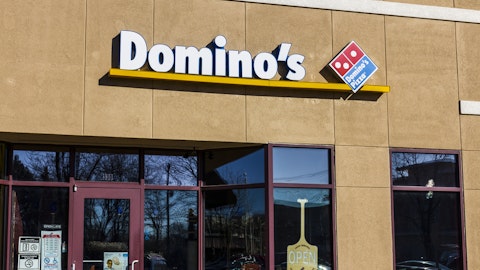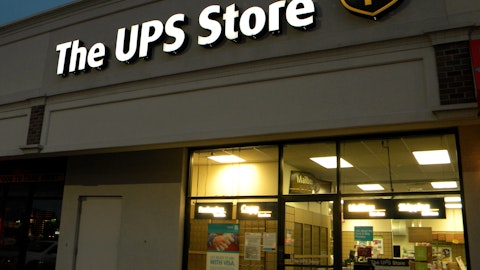Operator: And our next question comes from Peter Saleh from BTIG. Your line is now open.
Peter Saleh: Rob, I just wanted to kind of focus a little bit more on this supply chain change as it’s pretty meaningful. I think in the past you guys have had a higher supply chain margin and that’s come down over time and I know many of your peers have a higher margin. I’m just curious, how you think this impact the store base at least in the next year or two. Do you anticipate that some of the smaller franchisees may want to sell to some of the larger franchisees? Do you think the initial impact here is just slower development before the people digest this, the franchisees digest this? How do we think about this maybe in the context of 2024 and development, as we get into 2024 and 2025?
Rob Lynch: I want to make it very, very clear. This supply chain change will not be a material impact to the restaurant profitability. And when coupled with other programs that we are putting in place heading into 2024, there will be a net increase and improvement in restaurant profitability. The other piece I want to also make our own — during our — in our supply chain, we are always looking at productivity. So when you think about the impact of the restaurants of call it 30 basis points across the entire P&L from this change on an annual basis, our goal will be to mitigate a lot of that through productivity in the supply chain, so that this becomes even less material. And once again, with the volume based incentive that we’re offering, there — this will not be a material impact to restaurants.
I mean, we own 500 restaurants. Our goal in this system is to create the most profitable restaurant model for all of our franchisees as well as our company restaurants. And so, we do not anticipate this having any impact on franchisees closing or development moving forward once all the program components are implemented across the P&L.
Operator: And our next question comes from Joshua Long from Stephens Inc. Your line is now open.
Joshua Long: I was curious if you could talk about the back to better initiatives now that they’ve been across the system for a little while, any early learnings from that. I imagine that those have some tailwinds to them, especially as you put up great results like you did this morning. And then secondarily on that same note, as you think about kind of the back to better approach and then simplifying or at least optimizing operations and what that does in terms of unlock to support your menu innovation initiatives on a go forward basis?
Rob Lynch: Sure. Yes. I mean, right now, we are in a very quickly evolving operating environment. So as the business evolves to incorporate our aggregator partners in the aggregator channel as it evolves to a higher proportion of carryout business, we really need to optimize how we schedule, deploy, and manage labor across all of those channels. So, labor optimization is a big opportunity as you think about our business model leveraging external labor. So our back to better is not just about becoming more efficient in terms our out the door times and those other metrics, which by the way have improved dramatically. As I highlighted, we’ve moved our out the door times in our company markets from around 28 minutes to below 20 minutes at this point, which is transformational from a customer service and throughput standpoint, but it’s also about leveraging technology to make sure that we have the right labor in the right restaurants at the right time and that’s going to also make our restaurants more efficient, more productive, improve the P&Ls and drive more franchisee profitability.
Operator: And our next Question comes from Eric Gonzalez from KeyBanc. Your line is now open
Eric Gonzalez: My question is about the North America store level margin. I think you said food costs were 290 basis points better and that you levered labor by about 60 basis points. So I’m curious if you could help bridge the gap to the 130 basis points of improvement? And in terms of how much of a drag that increase in third-party mix was? And what does that say about the profitability of that channel? And really what’s driving that increase in third-party mix this quarter?
Ravi Thanawala: Thanks for the question, Eric. Couple of thoughts there. The first is, like, our focus is on, making sure we are serving the consumer on where they want to get Papa John’s and that’s across both their party aggregators as well as our organic digital channels. When we think about the impact of the change in sales mix across carryout delivery and third-party aggregators, it was about a 150 basis points of compression in the quarter. What’s important to note there is like, in the aggregators, as Rob mentioned, we are leaning in further into the lunch and late night day part. The shape of those transactions and what the consumer is purchasing at those parts of the day part are just different than dinner. And that’s yielding; one, a positive incremental, day part opportunity for us; but two, it does have some compression on the ticket.
Eric Gonzalez: Got it.
Rob Lynch: They are just smaller orders, which is going to drive lower ticket. It’s not necessarily cannibalization of our court dinner day part. It is adding new day parts that have a different ticket composition.
Eric Gonzalez: Is there a way you can maybe frame it, like, in terms of how much of the comp was driven by that part of the business?
Rob Lynch: I don’t know that we are necessarily breaking it out that way at this point, Eric.
Operator: [Operator Instructions] Alex Slagle, your line is now — Alex Slagle from Jefferies. Your line is now open.
Alex Slagle: Wanted to see if you could just talk to the path to improvements from the revenue management optimization work with the franchisees and sort of how far you have gotten there? How long you think it takes to get everyone on board and where you want to get to?
Rob Lynch: Great question. This is one of the more complex revenue management models in the industry. And the reason why I say that is, because, we have regular menu prices. We have specials and discounts that are promoted across all of our channels. And we have the aggregator pricing. We have a lot of different, moving pieces. When you drive through a drive through, when you look at the menu board, whatever the price is, is what you are going to pay, right. And you are not looking for special deals. When you go into our channels in our digital platforms, you are looking at not just our regular menu price, but you are looking at the promotions. You are also looking at all the specials and deals, and those can vary from different market, even by different stores within a market.
So as we think about revenue management, there really is a huge number of things to take into consideration to optimize every unique store’s individual profitability. And so, we have been working on that for really the last couple of years. We are about to enter into a big revenue management project, with some external partners to be able to digest all of our data and our franchisees data. And really give us that optimized model at a more local even a store basis, which is really hard for us to do with 3,400 restaurants with our internal infrastructure. So, we’re bringing in a partner that’s going to help us do that even, more productively. And so, it’s really just taking that project off. So, I think that that can pay a lot of dividends here in 2024.
Operator: And our next question comes from Brian Mullan from Piper Sandler. Your line is now open.
Brian Mullan: In the prepared remarks, you spoke to enhancing the loyalty program potentially having even better performance next year. Could you just elaborate on that a little bit? Are there consumer facing changes in the program you plan to make? Or is this maybe just about developing better internal capabilities to use the data with the current program you already have? Just any color you could add would be great.





